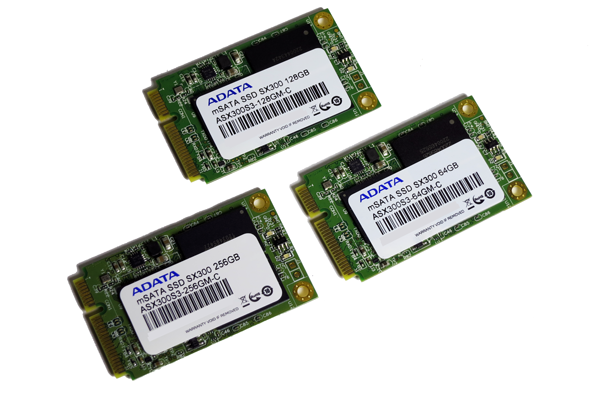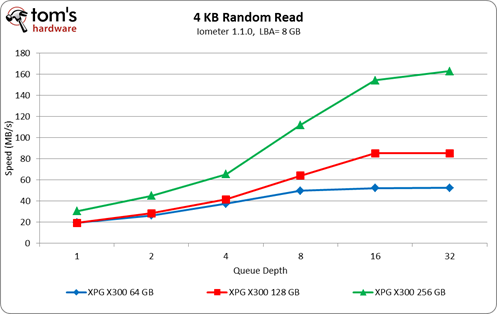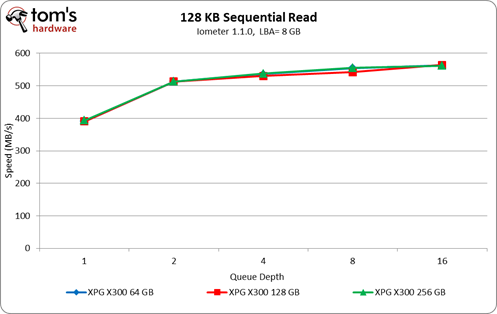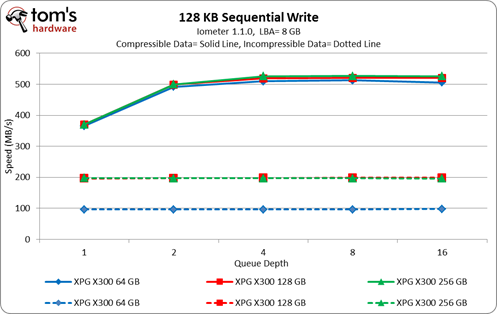Round-Up: 10 mSATA SSDs From Adata, Crucial, Mushkin, And OCZ
Adata XPG SX300 mSATA SSDs
Adata's XPG SX300 family is the mSATA-based relative of the company's 2.5" SX900 line-up, which we covered in Time To Upgrade: 10 SSDs Between 240 And 256 GB, Rounded Up. They both employ SandForce's second-generation controller, suggesting that we may just see the compact form factor serving up performance similar to what we've been enjoying on the desktop for more than two years now.
In reality, the XPG SX300s are a little different than the most conventional SandForce-based drives. Like the SX900s, Adata takes advantage of a vendor update from the controller company that allows it to disable over-provisioning entirely. In our review of the SX900, we saw that over-provisioning helps the drive recover performance when all of its cells are written to. Getting rid of the feature can affect speed then, under the right conditions.
You'll notice that the XPG SX300s (all three of them, at 64, 128, and 256 GB) host four BGA memory packages, each of which connects to the controller via two channels. Thus, all three mSATA-based SSDs communicate over eight available channels. Adata tells us that it's using 25 nm synchronous flash from IMFT, which should enable impressive performance.
Why is there so much difference between the three versions in our 4 KB random read test, then? At the low queue depths you'd expect to encounter on an Ultrabook or mainstream desktop, the drives are actually fairly close together. It's only at queue depths of eight and more that the 256 GB model really takes off. This is a result of the interleaving that takes place as more NAND devices are involved in a given operation. At high queue depths, the larger SSD is able to better-utilize the interface between SandForce's controller and the attached flash.
Writing compressible information to the XPG SX300s (in the chart below) doesn't leave any room for interleaving to help performance. SandForce's DuraWrite technology helps all three SSDs achieve similar results.
However, we know that SandForce's architecture doesn't handle compressed data as elegantly. So, the 128 and 256 GB drives serve up notably better performance than the 64 GB model, which is composed of few NAND die. Moreover, the trio's benchmark numbers are significantly lower when each drive is forced to contend with incompressible information.
Sequential read performance is notably better. All three drives post similarly-impressive throughput, sailing over 500 MB/s at a queue depth of two.
Get Tom's Hardware's best news and in-depth reviews, straight to your inbox.
So long as you're dealing with compressible data, 128 KB sequential write performance is also really impressive.
The impact of interleaving is profound once we force these mSATA-based SSDs to cope with purely incompressible information. The 128 and 256 GB models fall to 200 MB/s, while the 64G GB drive drops to 100 MB/s. Moreover, higher queue depths do nothing to improve transfer rates, since the architecture is already saturated at a queue depth of one. Stacking more operations only yields better performance when there's still headroom available.
Current page: Adata XPG SX300 mSATA SSDs
Prev Page Test Setup And Benchmarks Next Page Crucial m4 mSATA SSDs-
trumpeter1994 I just got a 256GB Crucial m4 msata SSD for the laptop I'm typing from. I love the thing its so nice to have in my y580Reply -
weatherdude Nice to see mSATA SSD's performing so well. Looks like laptops can now benefit from SSD's without having to compromise on storage space by giving up HDD's.Reply
Also the award is something new. I guess the "Recommended" and "Approved" awards are gone for 2013? -
cangelini weatherdudeNice to see mSATA SSD's performing so well. Looks like laptops can now benefit from SSD's without having to compromise on storage space by giving up HDD's.Also the award is something new. I guess the "Recommended" and "Approved" awards are gone for 2013?Approved is still one of the awards we're using. Recommended Buy is replaced by Smart Buy to better-convey the emphasis on value, and Best Of is replaced by Elite to better convey the emphasis on "this is the best damn product in the segment that we can recommend." Elites will continue to be something you rarely ever see, except when we want to make a point to honor a piece of hardware.Reply -
abbadon_34 Seems kinda underwhelming, seeing only 4 in the market, 2 of them years old. Ironically puts Intel's SSD and OCZ's in the same boat.Reply -
tsnor Excellent article. Nice. Much better than typical.Reply
Some discussion of trim, and the effects of using drives with a few days of use would have been good. The assumption is that the 'clean drive' performance tested is a good indicator of what people will see when they've used the drive for a month needs to be tested, the perforamnce order might change sharply. A 6 hour random write workload would go a long way to showing what to expect. Especially given the broken TRIM on SF 5 firmware and the slow speed of the fixes to existing SF drives. -
jaquith Yep, no argument the Crucial m4 mSATA 256 GB stole the show. It's both the fastest & cheapest -- what's the catch? I hope none.Reply
BTW - $179.99 or $0.70/GB (Promo Code: EMCYTZT2757) NewEgg - http://www.newegg.com/Product/Product.aspx?Item=N82E16820148613 Just noticed the sale from a NewEgg email. -
Onus I've got a 256GB Crucial M4 in the little clip on my Maximus V Gene as the boot drive. It's been performing flawlessly there for months.Reply
That's a bit crazy I know, but I had originally had it on the underside of an AZRock Z77E-ITX board until that board died. -
sna May I ask why is the Samsung 830 msata drive not present in this review?Reply
as I recall it outperforms the M4 and all the drives here.
-
edlivian oh great, now newegg and crucial are going to jack up the prices on the m4 line.Reply
I love the m4 drives, but now its going to get too much attention. -
jacobdrj snaMay I ask why is the Samsung 830 msata drive not present in this review?as I recall it outperforms the M4 and all the drives here.Because they are pretty much EOL with the 840 series out.Reply
I want to know when AMD laptops are going to start including msata slots... It is the budget laptop guys that would get the best benefit from msata with a standard HDD together...





